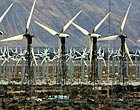Wind Mill Michigan

Hemlock, Mich. -- While Detroit's automakers struggle to rebuild their sputtering operations, the key to jump-starting Michigan's economy may lie 80 miles northwest of the Motor City.
This is the home of Hemlock Semiconductor Corp. It makes a material crucial for constructing photovoltaic panels. And that has turned this snow-covered hamlet into an unlikely hotbed for solar energy.
SolarLease.SolarCity.com
Green Energy Stocks
Our Top Stock Pick - UBRG
www.cleanenergy-review.com
A Fortune in Wind Energy
www.GreenChipStocks.com/Wind_Report
On Dec. 15, the same week that General Motors Corp. and Chrysler begged $17.4 billion from taxpayers to stave off collapse, Hemlock announced a $3-billion expansion that could create hundreds of jobs. It's a rare piece of good news for this battered Rust Belt state, whose 9.6% unemployment rate is the nation's highest.
In contrast to Detroit iron, Hemlock's quartz-based polycrystalline silicon is in such demand that workers in white smocks and protective gear toil around the clock to get it to customers around the globe.
Whether clean energy can pull Michigan out of the ditch remains to be seen. But the push is on to retool America with so-called green-collar industries.
President-elect Barack Obama wants to spend $150 billion over the next decade to promote energy from the sun, wind and other renewable sources as well as energy conservation. Plans include raising vehicle fuel-economy standards and subsidizing consumer purchases of plug-in hybrids. Obama wants to weatherize 1 million homes annually and upgrade the nation's creaky electrical grid. His team has talked of providing tax credits and loan guarantees to clean-energy companies.
His goals: create 5 million new jobs repowering America over 10 years; assert U.S. leadership on global climate change; and wean the U.S. from its dependence on imported petroleum.
"Breaking our oil addiction . . . is going to take nothing less than the complete transformation of our economy," Obama said during a campaign stop in Michigan's capital, Lansing, last year.
Americans have heard it before. Every president since Richard Nixon has touted energy independence, yet the goal remains elusive. The U.S. imported less than a third of its crude around the time of the Arab oil embargo in 1973. Today foreigners feed nearly 60% of the nation's petroleum habit.
Skeptics fear that the president-elect's Green New Deal will do little but waste taxpayers' money. The government squandered billions on the Jimmy Carter-era synthetic-fuels program, a failed effort to create vehicle fuel from coal.
Corn-based ethanol -- the latest recipient of fat subsidies -- is loathed by many environmentalists, who say it is an inefficient fuel that gobbles precious cropland and helps to drive up food prices.
Renewable-energy proponents such as former California Treasurer Phil Angelides say stupidity would be to stick with current U.S. energy policy, which has turbocharged global warming, super-sized the trade deficit and propped up oil-rich regimes hostile to American interests.
Angelides heads the Apollo Alliance, a coalition promoting clean industries as a means of rebuilding U.S. manufacturing and lessening the nation's dependence on foreign oil.
"It's the best path to recovery and the best chance of creating jobs that can't be outsourced," he said.
Although Angelides' organization takes its name from the space program that put Americans on the moon, creating green jobs isn't rocket science, said Oakland activist Van Jones, author of "The Green Collar Economy."

Comments
Post a Comment